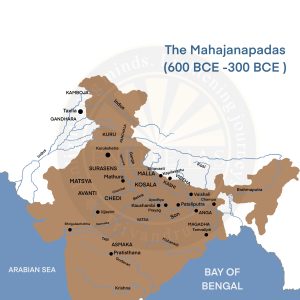Mahajanapadas
The Mahajanapadas were 16 large and powerful kingdoms that emerged in ancient India during the 6th century BCE.
- The Mahajanapadas were found in northern and eastern India.
- The modern-day states of Bihar, Uttar Pradesh, Haryana, and Madhya Pradesh were included.
- Magadha, Anga, Kashi, Kosala, Avanti, Vatsa, Gandhara, Kamboja, Chedi, Vajji, Malla, Kuru, Panchala, Matsya, Surasena, and Assaka were among the 16 Mahajanapadas.
- The Mahajanapadas were famous for their illustrious cultural heritage, military might, and economic success.

Political Structure
- Mahajanapadas were republics (Ganas or Sanghas), monarchies, or oligarchies. Most of them were monarchies.
- Monarchies were ruled by a king who wielded supreme power and was assisted by a council of ministers.
- A council of elected members ruled the republics. The executive head was the council’s chairman.
- King had to consult Brahmana, the council of ministers (mantri-parishad), and Rajsabha before making important decisions. He would always be obedient to Brahmanas.
- Oligarchies were ruled by a few people who wielded power over the masses.
- Each of the Mahajanapadas had its capital city.
- The Mahajanapadas had a complex administrative system with several officials holding various responsibilities.
- The king was in charge of the kingdom’s defense, and the army was the state’s backbone.
- The Mahajanapadas had an efficient income collection system. Taxes were collected from a variety of sources.
Socio-Economic Condition
- Nobles, tradesmen, farmers, and workers were among several classes in society.
- During this time, the caste system was not fully evolved.
- Kassaka and ksetrika were terms for common peasants who belonged to the Sudra jati.
- Slavery was common, and slaves were utilized for a variety of manual tasks.
- Marriage alliances were an important component of inter-state interactions, but they were frequently rendered meaningless when it came to achieving political goals.
- Agriculture was the people’s principal activity, and the kingdoms were mostly agrarian.
- The kingdoms had well-established trade routes, and trade and commerce prospered.
- Coinages: The kingdoms issued their own coinage for trade and commerce.
- The coins were often composed of silver or copper, and they were frequently imprinted with symbols and inscriptions that reflected the state’s political and cultural identity.
- The coins were dubbed punch-marked because they were imprinted with a series of symbols and dots punched into the metal.
Reasons that led to the Development of Mahajanapadas
Several causes influenced the formation of Mahajanapadas, which can be seen in the context of social, economic, and political events at the time:
- Agricultural Surplus: As agriculture developed, food production rose, resulting in surplus resources. Because of this surplus, certain communities were able to flourish and prosper, resulting in the establishment of increasingly sophisticated governmental institutions.
- Trade and Commerce: The thriving trade routes and economic activities allowed for the buildup of wealth. Control over trade routes and access to lucrative resources were motivations for territorial entity development.
- The decline of the Vedic traditional order caused a power vacuum, resulting in the rise of more organized and centralized governmental organizations. The Mahajanapadas were created in response to the necessity for stronger governmental bodies to keep the peace.
- Conflict over resources: Conflicts arose as a result of rivalry for fertile land, water supplies, and trade routes. The Mahajanapadas were formed in part to address the need for stronger political organizations to preserve and extend territories.
- Population Growth: As the population and towns grew, so did the need for more organized governing systems. Larger societies necessitated more sophisticated administrative structures for resource management and dispute resolution.
- Class Distinctions Emerge: As economies developed, social stratification evolved. As a result, powerful ruling elites rose to solidify their power through political entities.

